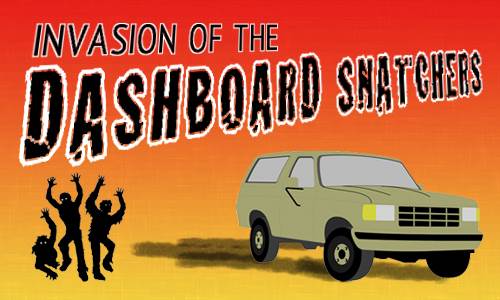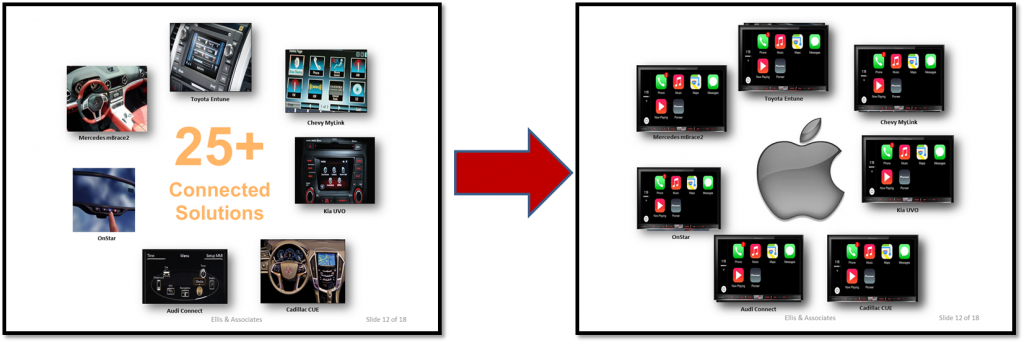I’ve spoken to many people during the past week who attended DASH to get a sense of which sessions resonated. One of the speakers who just about everyone points to is John Ellis, former Ford executive who stepped out on his own this year.
John is an outspoken, untethered insider with knowledge about the present and insight about the future. One of the truisms about the “connected car” is that every car company (OEM) has developed their proprietary technology. While this may serve their companies well, the end result for consumers is that there’s a learning curve – often step – when you drive or rent a new vehicle. The lack of standardization can be frustrating because no two systems are alike.
As a result, both Apple and Google have stepped into the fray with their own dashboard platforms. The root of their thinking – confirmed by J.D. Power’s Dave Sargent in his DASH presentation – is that consumers are more loyal to their phones than their car brands. Apple’s CarPlay and Google’s Android Auto mimic your smartphone desktop by porting over selected apps to your dashboard display screen.
The result is a seamless, familiar interface accompanied by voice command systems the consumer knows well (Siri and Google Voice respectively) to guide platforms that easily connect to dashboards, essentially circumventing the OEM’s system.
But it’s not just car companies that are impacted by Apple and Google’s technology. As Ellis pointed out in his DASH diatribe, broadcast radio’s presence in Apple CarPlay and Android Auto is not on the center stage. In fact, drivers will have more buttons to push in order to return to their normal screens and their favorite AM/FM radio stations. This will take effort, and because the Apple or Google systems launch when a consumer starts the car, broadcast radio gets quietly pushed to the background.
At CES last January, both Apple and Google’s in-dash solutions were on display by many of the OEMs (and aftermarket brands like Pioneer). We shot this video featuring walk-throughs from Chevy and Volkswagen of identical Apple CarPlay and Android Auto systems that provide a high level of standardization in the highly fragmented dashboard space. Problem is, where’s radio?
Email recipients can click here to see the Apple CarPlay | Android Auto video
While broadcasters need to be conversant with the technologies and systems offered by the OEMs, now the world’s two biggest technology companies have entered the dashboard arena, with the goal of becoming the dominant players in the space.
To date, more than 20 car manufacturers have expressed support for both Apple and Google’s in-dash platforms, including GM and Ford. These systems are already on display in showrooms around the country. As Ellis notes, the way to think about these ecosystems is “one solution, all vehicles.” He graphically showed how this looks by showing a number of different OEM dashboard platforms all morphing into the Apple CarPlay platform.
Ellis’ presentation was the most talked-about at DASH, and one that was repeatedly mentioned in our post-conference surveys. And for good reason. It was a reminder that the radio business needs to go to school in the automotive space. Connecting with the OEMs – and now Apple and Google – should be industry initiatives to ensure that broadcast radio has solid representation in the dashboards – and in-car ecosystems – of today and the future.
John’s advice to the capacity crowd at DASH? Be paranoid. And cut deals with Apple and Google.
So two ideas to leave you with:
First, our twelfth Techsurvey is open for registration here. Along with many other key areas of investigation, we are tracking radio’s connection to the car, as well as learning about your audience’s car purchasing patterns and dashboard behavior. Any station with a respectable database can participate, and in the process, receive national and format data, as well as their local station’s results. For just a few hundred bucks, you can learn how the “connected car” is being received right now today by your core listeners. This is how the radio industry learns about the impact of the automotive sector on both listening and sales.
Second, Paul and I will be returning to CES for the seventh consecutive year, armed with comfortable shoes and video cameras. While we intend to see and experience as much as possible at the world’s largest trade show, our focus will be on automotive. Look for an industry webinar in first quarter, and updated information about the changing relationship between radio and cars.
Thanks to John Ellis, and the 40+ speakers and presenters from both the radio and automotive industries who graced our Detroit stage. And thanks to those of you who attended DASH.
The journey continues.
- What To Do If Your Radio Station Goes Through A Midlife Crisis - April 25, 2025
- A 2020 Lesson?It Could All Be Gone In A Flash - April 24, 2025
- How AI Can Give Radio Personalities More…PERSONALITY - April 23, 2025






It would appear the RAB has a new raison d’etre! Radio is a cottage industry compared to Google and Apple, and we reach far more people every day. The fight will likely need to be driven by our listener’s “popular demand” in order to hold our place on the Dashboard.
Exactly right, Charlie. We need to be sure we’re programming essential content for local markets. Thanks for the comment.